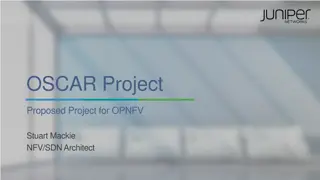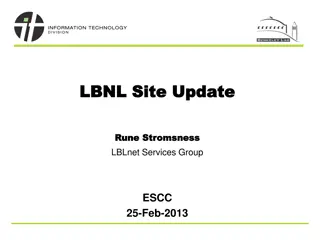RPKI Deployment and Security Overview
Explore the key concepts of RPKI deployment and security, including preventing prefix/subprefix hijacks, certifying ownership with RPKI, and how RPKI can prevent prefix hijacks. Learn about challenges in deployment and the importance of route origin validation. Understand the risks of insecure deployment and the role of ROAs in securing interdomain routing.
Download Presentation

Please find below an Image/Link to download the presentation.
The content on the website is provided AS IS for your information and personal use only. It may not be sold, licensed, or shared on other websites without obtaining consent from the author.If you encounter any issues during the download, it is possible that the publisher has removed the file from their server.
You are allowed to download the files provided on this website for personal or commercial use, subject to the condition that they are used lawfully. All files are the property of their respective owners.
The content on the website is provided AS IS for your information and personal use only. It may not be sold, licensed, or shared on other websites without obtaining consent from the author.
E N D
Presentation Transcript
Are We There Yet? On RPKI Deployment and Security Yossi Gilad joint work with: Avichai Cohen, Amir Herzberg, Michael Schapira, Haya Shulman
The Resource Public Key Infrastructure Intended to prevent prefix/subprefix hijacks Lays the foundation for protection against more sophisticated attacks on interdomain routing BGPsec, SoBGP, 2
Prefix Hijacking prefers shorter route AS X 91.0.0.0/10 Path: Y-3320 91.0.0.0/10 Path: 666 AS Y AS 666 91.0.0.0/10 Path: 3320 AS 3320 BGP Ad. Data flow 3
Subprefix Hijacking Longest prefix match Path length does not matter AS X 91.0.0.0/10 Path: 3320 91.0.0.0/16 Path: Y-666 AS Y AS 3320 91.0.0.0/16 Path: 666 AS 666 BGP Ad. Data flow 4
Certifying Ownership with RPKI RPKI assigns an IP prefix to a public key via a Resource Certificate (RC) Owners can use their private key to issue a Route Origin Authorization (ROA) ROAs identify ASes authorized to advertise an IP prefix in BGP 5
Example: Certifying Ownership Deutsche Telekom certified by RIPE for address space 91.0.0.0/10 RIPE Legend: R seaux IP Europ ens Network Coordination Centre Org with RC 91.0.0.0/10 Max-length = 10 AS 3320 Deutsche Telekom 91.0.0.0/10 ROA 6
RPKI Can Prevent Prefix Hijacks AS X uses the authenticated mapping (ROA) from 91.0/10 to AS 3320 to discard the attacker s route-advertisement 91.0.0.0/10 Path: Y-3320 91.0.0.0/10 Path: 666 AS X 91.0.0.0/10 Max-length = 10 AS 3320 AS Y AS 666 AS 3320 BGP Ad. Data flow 7
Talk Outline Challenges facing deployment Route origin validation in partial deployment 8
Insecure Deployment: Loose ROAs 1.2.0.0/16 Max-length = 16 AS A Picks shorter path ROA allows advertising only one /16 prefix Valid advertisement since AS A is the origin AS X 1.2.0.0/16 Path: A 1.2.0.0/16 Path: 666-A AS A AS 666 BGP Ad. Data flow 9 Lychev et al. show that this attack is much less effective than prefix hijack
Insecure Deployment: Loose ROAs 1.2.0.0/16 Max-length = 24 AS A Longest-prefix-match Path length does not matter ROA allows advertising subprefixes up to length /24 AS A originates 1.2.0.0/16 but not 1.2.3.0/24 ROA is loose 1.2.0.0/16 Path: A Valid advertisement since AS A is the origin AS X 1.2.3.0/24 Path: 666-A AS A AS 666 BGP Ad. Data flow 10 RFC 7115 mentions this attack
Insecure Deployment: Loose ROAs Loose ROAs are common! almost 30% of IP prefixes in ROAs 89% of prefixes with maxLen > prefixLen manifests even in large providers! Attacker can hijack all traffic to non-advertised subprefixes covered by a loose ROA Vulnerability will be solved only when BGPsec is fully deployed, but a long way to go until then better not to issue loose ROAs! 11
Challenges to Deployment: Human Error Many other mistakes in ROAs (see RPKI monitor) ``bad ROAs cause legitimate prefixes to appear invalid filtering by ROAs may cause disconnection from legitimate destinations extensive measurements in [Iamartino et al., PAM 15] 12
Improving Accuracy with ROAlert roalert.org allows you to check whether your network is properly protected by ROAs and if not, why not 13
Improving Accuracy with ROAlert Online, proactive notification system Retrieves ROAs from the RPKI and compares them against BGP advertisements Alerts network operators about loose ROAs & bad ROAs 14
Improving Accuracy with ROAlert Initial results are promising! notifications reached 168 operators 42% of errors were fixed within a month ROAlert is: constantly monitoring (not only at registration) not opt-in We advocate that ROAlert be adopted and adapted by RIRs! 15
Talk Outline Challenges facing deployment Route origin validation in partial deployment 16
Filtering Bogus Advertisements Route-Origin Validation (ROV): use ROAs to discard/deprioritize route-advertisements from unauthorized origins [RFC 6811] Autonomous System Verify: signer authorized for subject prefix signature is valid RPKI cache RCs and ROAs RPKI pub. point 91.0.0.0/10: AS = 3320, max-length = 10 BGP Routers 17
What is the Impact of Partial ROV Adoption? Collateral benefit: Adopters protect ASes behind them by discarding invalid routes C:\Users\Administrator\AppData\Local\Microsoft\Windows\Temporary Internet Files\Content.IE5\OUIM4F8E\MC900435931[1].wmf 1.1.0.0/16 Max-length = 16 AS 1 To: 1.1.1/24 AS path: 666 AS 3 is only offered a good route AS 666 AS 2 AS 3 To: 1.1/16 AS path: 2-1 Origin AS 1 18
What is the Impact of Partial ROV Adoption? Collateral damage: ASes not doing ROV might cause ASes that do ROV to fall victim to attacks! Disconnection: Adopters might be offered only bad routes C:\Users\Administrator\AppData\Local\Microsoft\Windows\Temporary Internet Files\Content.IE5\OUIM4F8E\MC900435931[1].wmf 1.1.0.0/16 Max-length = 16 AS 1 AS 3 receives only bad advertisement and disconnects from 1.1/16 To: 1.1/16 AS path: 2-666 AS 666 AS 2 AS 3 AS 2 prefers to advertise routes from AS 666 over AS 1 To: 1.1/16 AS path: 1 Origin AS 1 19
What is the Impact of Partial ROV Adoption? Collateral damage: ASes not doing ROV might cause ASes that do ROV to fall victim to attacks! Control-Plane-Data-Plane Mismatch! data flows to attacker, although AS 3 discarded it C:\Users\Administrator\AppData\Local\Microsoft\Windows\Temporary Internet Files\Content.IE5\OUIM4F8E\MC900435931[1].wmf 1.1.0.0/16 Max-length = 16 AS 1 To: 1.1.1/24 AS path: 2-666 AS 666 AS 3 discards bad subprefix route AS 2 advertises both prefix & subprefix routes AS 2 does not filter and uses bad route for subprefix AS 2 AS 3 To: 1.1/16 AS path: 2-1 Origin AS 1 20
Quantify Security in Partial Adoption: Simulation Framework Pick victim & attacker Victim s prefix has a ROA Pick set of ASes doing ROV Evaluate which ASes send traffic to the attacker 1.1.0.0/16 Max-length = 16 AS A A B C D E F G H I J C:\Users\Administrator\AppData\Local\Microsoft\Windows\Temporary Internet Files\Content.IE5\OUIM4F8E\MC900435931[1].wmf K L Empirically-derived AS-level network from CAIDA Including inferred peering links [Giotsas et al., SIGCOMM 13] 21
Quantify Security in Partial Adoption Top ISP adopts with probability p Significant benefit only when p is high Subprefix hijack Prefix hijack success rate success rate 22
Conclusion: What Can We Improve? Information accuracy ROAlert informs & alerts operators about: Bad ROAs Loose ROAs Preventing hijacks Incentivize ROV adoption by the top ISPs! 23
Thank You! This work appeared at NDSS 17 Tech report at https://eprint.iacr.org/2016/1010.pdf Questions? 24






























